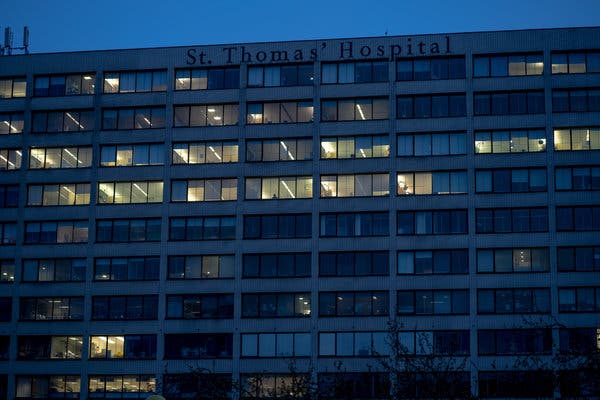LONDON — Within 10 days of the British government’s lockdown announcement in late March, one woman lost all nine of her cleaning jobs. Another was laid off from a laundromat after she requested a mask, and a live-in nanny was fired for using public transport on her day off.
In separate interviews, the three women said that they had expected to confront hardships during the lockdown. But as the economy starts to reopen, they and other women on the lower rungs of the economy say they are still struggling, weighed down by debts accumulated during the freeze and often facing pay cuts or forced to do more work for the same wages.
The three have one other thing in common. They are all women of color, a group that has long faced economic and racial inequality in Britain and is now being hit disproportionately by the financial and psychological impacts of the coronavirus pandemic, according to a recent study by a group of British universities and women’s charities.
“Covid-19 has brought the harsh realities of pre-existing racial inequalities into sharp relief, and nowhere is this more manifest than the disproportionate social and economic impact of Covid-19 on Black and ethnic minority women,” said Zubaida Haque, the interim director of the Runnymede Trust, a London-based organization advocating racial equality.
The main reason that people of color are so vulnerable, experts say, is that they are more likely to be in precarious employment or to become unemployed, making it harder for them to qualify for government support and to protect themselves from the virus.
Minji Paik, a Korean beautician who works in a hair salon in East London, said she made 15 pounds an hour before the pandemic, about $19 dollars, plus tips. Now she is making £10 an hour, and has been working longer shifts because of staff shortages.
“My manager says this is temporary and she will give me more money when we make money,” Ms. Paik said. “But actually, I should be paid more because I’m working inside and risking my health.”
A government review of the disparities in the risk and outcomes from the coronavirus found that death rates have been higher in Black, Asian and other minority ethnic groups than in white groups. The review found that Chinese, Indian, Pakistani and other Asians, as well as Caribbeans and other Black people, had from 10 percent to 50 percent higher risk of death than white Britons.
“There’s often a risk when people start talking about the underlying causes of death because of the assumption that the reason is related to genetics or poor diets,” said Bridget Byrne, director of the Center on Dynamics of Ethnicity at the University of Manchester. “But actually, you need to look at the wider process of racism and the structuring of race and deprivation.”
The precarious nature of the current labor market is a contributing factor as well, Ms. Byrne said. “It makes people less willing to voice their concerns, they worry that if they say, ‘I don’t feel safe, I don’t think I should be coming in,’ they will be the first to be laid off.”
Candice Brown, 48, a cleaner who is of Jamaican descent, said she had lost all her clients when lockdown measures were imposed in March.
“They phoned me one by one to say don’t come,” she recalled, referring to the owners of the nine houses she cleaned each week in the city of Manchester, in northwestern England. “Each call was like a bomb, blasting every bit of my livelihood until I had no work left.”
For two months she tried to navigate the government’s financial support system for those affected by the pandemic, and even borrowed money from a friend to hire an accountant to help. But eventually, she found out that she was not eligible for any aid because she lacked the paperwork to prove her employment history.
“I applied for universal credit,” she said referring to the government’s income support program. “But I am still waiting. I haven’t received a penny.”
Even with the easing of the lockdown measures, Ms. Brown has not been invited back to work because her employers fear that she could contract and spread the virus by working between multiple households.
“I don’t know how much longer I can go on like this,” she said. “In the first month, I was worrying about how to pay my rent and my bills, now I can’t sleep worrying about how to feed my children.”
A survey published by the Fawcett Society, a women’s rights charity, found that nearly 43 percent of Black and ethnic minority women believed that they would be in more debt than before the pandemic, compared with 37 percent of white women and 34 percent of white men. More than four in 10 of the women said they would struggle to make ends meet over the next three months.
Many are tasked with carrying out menial tasks that can be perilous in a pandemic, a recent study by the Runnymede Trust found.
Zuhr Rind, 48, a Pakistani laundromat worker in East London, was asked to work the last shift when the pandemic broke out so that she could wash the uniforms of the front-of-house employees, who collected laundry from clients.
The Coronavirus Outbreak ›
Frequently Asked Questions
Updated July 15, 2020
-
Is the coronavirus airborne?
- The coronavirus can stay aloft for hours in tiny droplets in stagnant air, infecting people as they inhale, mounting scientific evidence suggests. This risk is highest in crowded indoor spaces with poor ventilation, and may help explain super-spreading events reported in meatpacking plants, churches and restaurants. It’s unclear how often the virus is spread via these tiny droplets, or aerosols, compared with larger droplets that are expelled when a sick person coughs or sneezes, or transmitted through contact with contaminated surfaces, said Linsey Marr, an aerosol expert at Virginia Tech. Aerosols are released even when a person without symptoms exhales, talks or sings, according to Dr. Marr and more than 200 other experts, who have outlined the evidence in an open letter to the World Health Organization.
-
What are the symptoms of coronavirus?
- Common symptoms include fever, a dry cough, fatigue and difficulty breathing or shortness of breath. Some of these symptoms overlap with those of the flu, making detection difficult, but runny noses and stuffy sinuses are less common. The C.D.C. has also added chills, muscle pain, sore throat, headache and a new loss of the sense of taste or smell as symptoms to look out for. Most people fall ill five to seven days after exposure, but symptoms may appear in as few as two days or as many as 14 days.
-
What’s the best material for a mask?
- Scientists around the country have tried to identify everyday materials that do a good job of filtering microscopic particles. In recent tests, HEPA furnace filters scored high, as did vacuum cleaner bags, fabric similar to flannel pajamas and those of 600-count pillowcases. Other materials tested included layered coffee filters and scarves and bandannas. These scored lower, but still captured a small percentage of particles.
-
Is it harder to exercise while wearing a mask?
- A commentary published this month on the website of the British Journal of Sports Medicine points out that covering your face during exercise “comes with issues of potential breathing restriction and discomfort” and requires “balancing benefits versus possible adverse events.” Masks do alter exercise, says Cedric X. Bryant, the president and chief science officer of the American Council on Exercise, a nonprofit organization that funds exercise research and certifies fitness professionals. “In my personal experience,” he says, “heart rates are higher at the same relative intensity when you wear a mask.” Some people also could experience lightheadedness during familiar workouts while masked, says Len Kravitz, a professor of exercise science at the University of New Mexico.
-
I’ve heard about a treatment called dexamethasone. Does it work?
- The steroid, dexamethasone, is the first treatment shown to reduce mortality in severely ill patients, according to scientists in Britain. The drug appears to reduce inflammation caused by the immune system, protecting the tissues. In the study, dexamethasone reduced deaths of patients on ventilators by one-third, and deaths of patients on oxygen by one-fifth.
-
What is pandemic paid leave?
- The coronavirus emergency relief package gives many American workers paid leave if they need to take time off because of the virus. It gives qualified workers two weeks of paid sick leave if they are ill, quarantined or seeking diagnosis or preventive care for coronavirus, or if they are caring for sick family members. It gives 12 weeks of paid leave to people caring for children whose schools are closed or whose child care provider is unavailable because of the coronavirus. It is the first time the United States has had widespread federally mandated paid leave, and includes people who don’t typically get such benefits, like part-time and gig economy workers. But the measure excludes at least half of private-sector workers, including those at the country’s largest employers, and gives small employers significant leeway to deny leave.
-
Does asymptomatic transmission of Covid-19 happen?
- So far, the evidence seems to show it does. A widely cited paper published in April suggests that people are most infectious about two days before the onset of coronavirus symptoms and estimated that 44 percent of new infections were a result of transmission from people who were not yet showing symptoms. Recently, a top expert at the World Health Organization stated that transmission of the coronavirus by people who did not have symptoms was “very rare,” but she later walked back that statement.
-
What’s the risk of catching coronavirus from a surface?
- Touching contaminated objects and then infecting ourselves with the germs is not typically how the virus spreads. But it can happen. A number of studies of flu, rhinovirus, coronavirus and other microbes have shown that respiratory illnesses, including the new coronavirus, can spread by touching contaminated surfaces, particularly in places like day care centers, offices and hospitals. But a long chain of events has to happen for the disease to spread that way. The best way to protect yourself from coronavirus — whether it’s surface transmission or close human contact — is still social distancing, washing your hands, not touching your face and wearing masks.
-
How does blood type influence coronavirus?
- A study by European scientists is the first to document a strong statistical link between genetic variations and Covid-19, the illness caused by the coronavirus. Having Type A blood was linked to a 50 percent increase in the likelihood that a patient would need to get oxygen or to go on a ventilator, according to the new study.
-
How can I protect myself while flying?
- If air travel is unavoidable, there are some steps you can take to protect yourself. Most important: Wash your hands often, and stop touching your face. If possible, choose a window seat. A study from Emory University found that during flu season, the safest place to sit on a plane is by a window, as people sitting in window seats had less contact with potentially sick people. Disinfect hard surfaces. When you get to your seat and your hands are clean, use disinfecting wipes to clean the hard surfaces at your seat like the head and arm rest, the seatbelt buckle, the remote, screen, seat back pocket and the tray table. If the seat is hard and nonporous or leather or pleather, you can wipe that down, too. (Using wipes on upholstered seats could lead to a wet seat and spreading of germs rather than killing them.)
-
What should I do if I feel sick?
- If you’ve been exposed to the coronavirus or think you have, and have a fever or symptoms like a cough or difficulty breathing, call a doctor. They should give you advice on whether you should be tested, how to get tested, and how to seek medical treatment without potentially infecting or exposing others.
“I was not happy about it, but what could I do? Work is work and I was afraid to lose my job if I made an argument,” she said.
When she asked for a face mask, her manager chided her, she said.
“That is pathetic Z,” her manager wrote back in a text message she showed to The New York Times. “Doctors and nurses do not even have enough masks and they’re still going to work.”
A day later, Ms. Rind said, she was laid off. “When you have brown skin, when you have an accent and when you don’t have a high education, you don’t have choices,” she said. “And this is a very dangerous situation to be in during Covid.”
The laundromat where she worked did not respond to a request for comment.
Ms. Rind was recently offered a cleaning job in a hotel but was forced to turn it down because she lives 40 minutes away and, as a precaution against the virus, the employer did not want her to take public transport.
Black and ethnic minority women also generally have much lower levels of savings and assets than white Britons, according to the Runnymede Trust study. So those who lost their jobs in the pandemic have had to seek new employment straight away, forcing some of them to take lower-paid, higher-risk posts.
Verona Pollard, an experienced nanny and maternity nurse, has taken up part-time child care work since she was fired from a full-time nannying job, after her employer found out she had taken public transport on her days off.
“She was ruthless about it and wouldn’t take me back, even when the lockdown was lifted,” she said in a phone interview. “ It’s been brutal since then, I’m just doing odd jobs here and there.”
And in the Fawcett Society’s survey, work-related anxiety was highest among Black and minority ethnic women, with 65.1 percent of women employed outside the home reporting that they felt apprehensive as a result of having to go to work during the pandemic.
Ms. Brown, the cleaner in Manchester, said that she was still waiting for her unemployment benefits to come through and that she had been borrowing money from a friend and from a former employer to get by. In recent weeks, she said she has become so stressed and anxious that rashes have broken out over her body and she has noticed her hair falling out.
“I promise you, what I am going through now is worse than any virus,” she said.



















